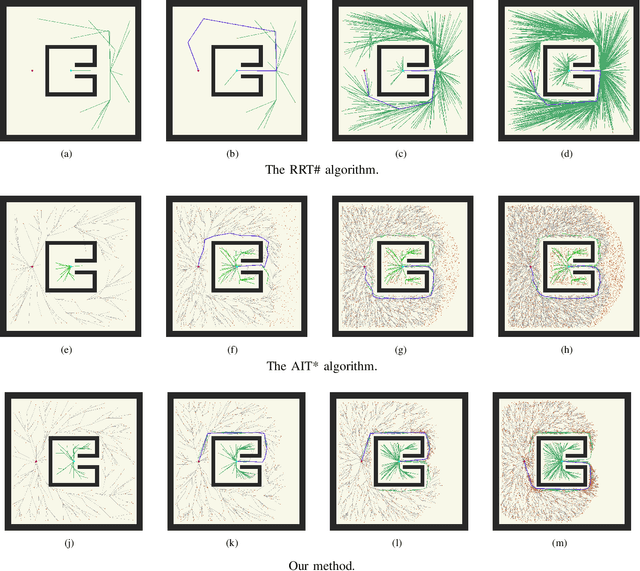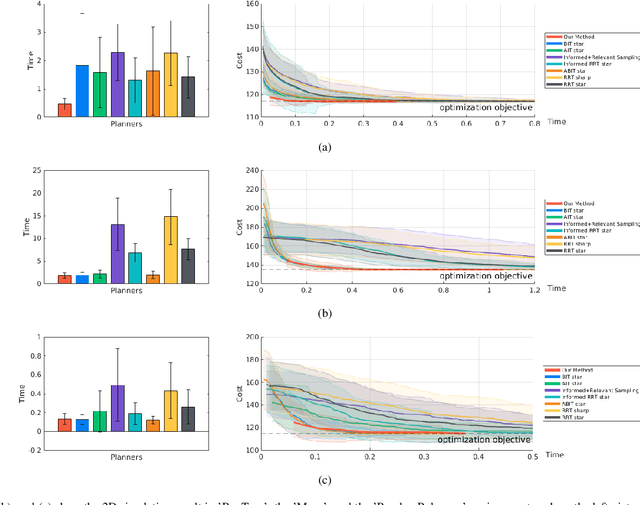Fei Meng
Online Time-Informed Kinodynamic Motion Planning of Nonlinear Systems
Jul 03, 2024



Abstract:Sampling-based kinodynamic motion planners (SKMPs) are powerful in finding collision-free trajectories for high-dimensional systems under differential constraints. Time-informed set (TIS) can provide the heuristic search domain to accelerate their convergence to the time-optimal solution. However, existing TIS approximation methods suffer from the curse of dimensionality, computational burden, and limited system applicable scope, e.g., linear and polynomial nonlinear systems. To overcome these problems, we propose a method by leveraging deep learning technology, Koopman operator theory, and random set theory. Specifically, we propose a Deep Invertible Koopman operator with control U model named DIKU to predict states forward and backward over a long horizon by modifying the auxiliary network with an invertible neural network. A sampling-based approach, ASKU, performing reachability analysis for the DIKU is developed to approximate the TIS of nonlinear control systems online. Furthermore, we design an online time-informed SKMP using a direct sampling technique to draw uniform random samples in the TIS. Simulation experiment results demonstrate that our method outperforms other existing works, approximating TIS in near real-time and achieving superior planning performance in several time-optimal kinodynamic motion planning problems.
NR-RRT: Neural Risk-Aware Near-Optimal Path Planning in Uncertain Nonconvex Environments
May 14, 2022



Abstract:Balancing the trade-off between safety and efficiency is of significant importance for path planning under uncertainty. Many risk-aware path planners have been developed to explicitly limit the probability of collision to an acceptable bound in uncertain environments. However, convex obstacles or Gaussian uncertainties are usually assumed to make the problem tractable in the existing method. These assumptions limit the generalization and application of path planners in real-world implementations. In this article, we propose to apply deep learning methods to the sampling-based planner, developing a novel risk bounded near-optimal path planning algorithm named neural risk-aware RRT (NR-RRT). Specifically, a deterministic risk contours map is maintained by perceiving the probabilistic nonconvex obstacles, and a neural network sampler is proposed to predict the next most-promising safe state. Furthermore, the recursive divide-and-conquer planning and bidirectional search strategies are used to accelerate the convergence to a near-optimal solution with guaranteed bounded risk. Worst-case theoretical guarantees can also be proven owing to a standby safety guaranteed planner utilizing a uniform sampling distribution. Simulation experiments demonstrate that the proposed algorithm outperforms the state-of-the-art remarkably for finding risk bounded low-cost paths in seen and unseen environments with uncertainty and nonconvex constraints.
Relevant Region Sampling Strategy with Adaptive Heuristic Estimation for Asymptotically Optimal Motion Planning
Oct 31, 2021



Abstract:The sampling-based motion planning algorithms can solve the motion planning problem in high-dimensional state space efficiently. This article presents a novel approach to sample in the promising region and reduce planning time remarkably. The RRT# defines the Relevant Region according to the cost-to-come provided by the optimal forward-searching tree; however, it takes the cumulative cost of a direct connection between the current state and the goal state as the cost-to-go. We propose a batch sampling method that samples in the refined Relevant Region, which is defined according to the optimal cost-to-come and the adaptive cost-to-go. In our method, the cost-to-come and the cost-to-go of a specific vertex are estimated by the valid optimal forward-searching tree and the lazy reverse-searching tree, respectively. New samples are generated with a direct sampling method, which can take advantage of the heuristic estimation result. We carry on several simulations in both SE(2) and SE(3) state spaces to validate the effectiveness of our method. Simulation results demonstrate that the proposed algorithm can find a better initial solution and consumes less planning time than related work.
Hierarchical Policy for Non-prehensile Multi-object Rearrangement with Deep Reinforcement Learning and Monte Carlo Tree Search
Sep 18, 2021



Abstract:Non-prehensile multi-object rearrangement is a robotic task of planning feasible paths and transferring multiple objects to their predefined target poses without grasping. It needs to consider how each object reaches the target and the order of object movement, which significantly deepens the complexity of the problem. To address these challenges, we propose a hierarchical policy to divide and conquer for non-prehensile multi-object rearrangement. In the high-level policy, guided by a designed policy network, the Monte Carlo Tree Search efficiently searches for the optimal rearrangement sequence among multiple objects, which benefits from imitation and reinforcement. In the low-level policy, the robot plans the paths according to the order of path primitives and manipulates the objects to approach the goal poses one by one. We verify through experiments that the proposed method can achieve a higher success rate, fewer steps, and shorter path length compared with the state-of-the-art.
 Add to Chrome
Add to Chrome Add to Firefox
Add to Firefox Add to Edge
Add to Edge